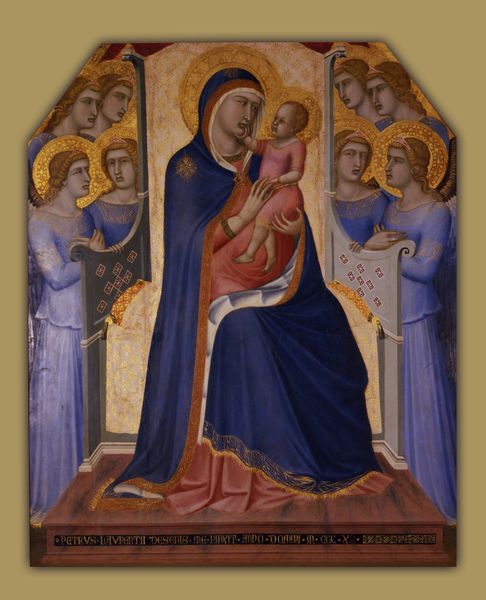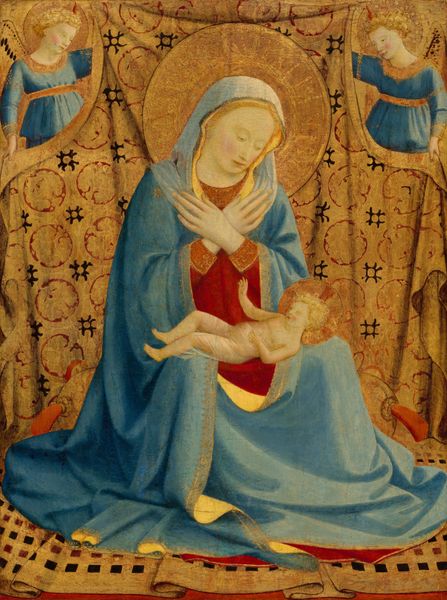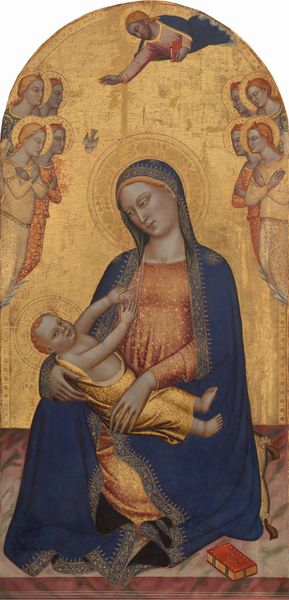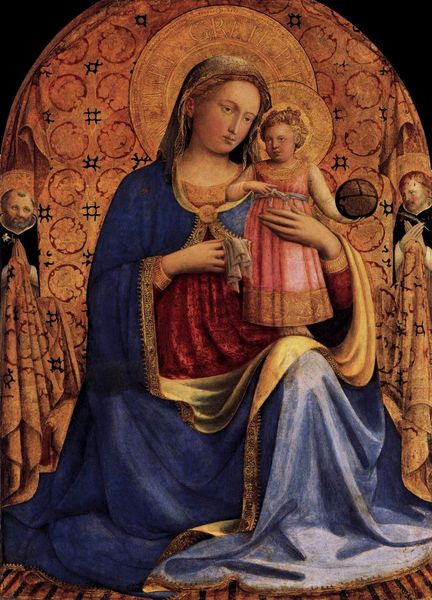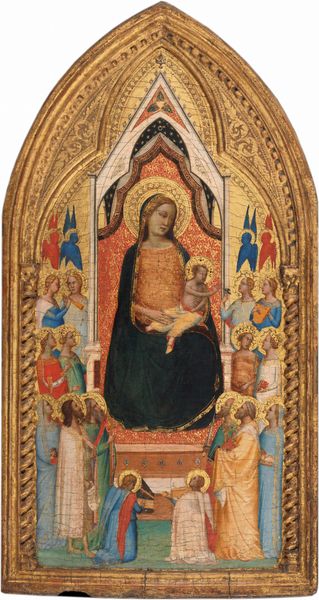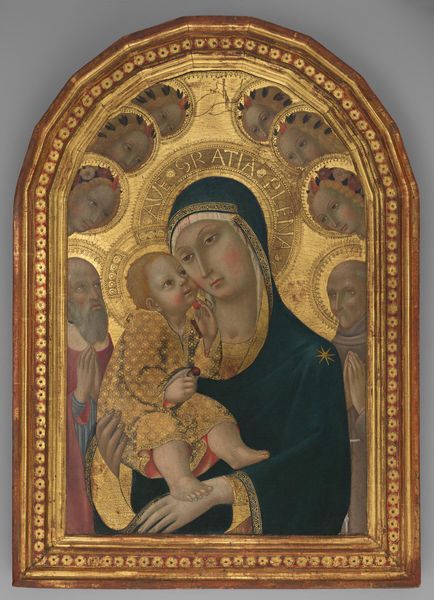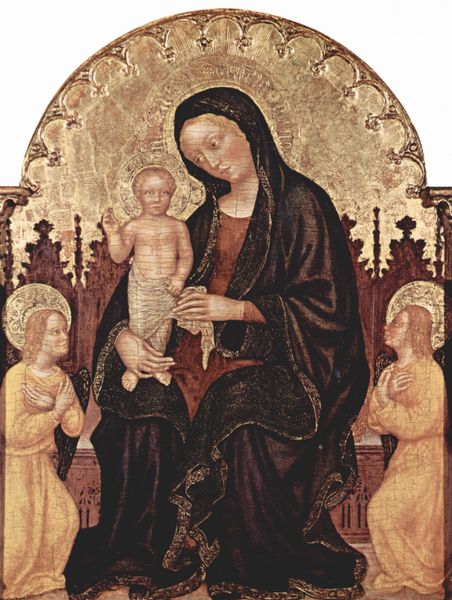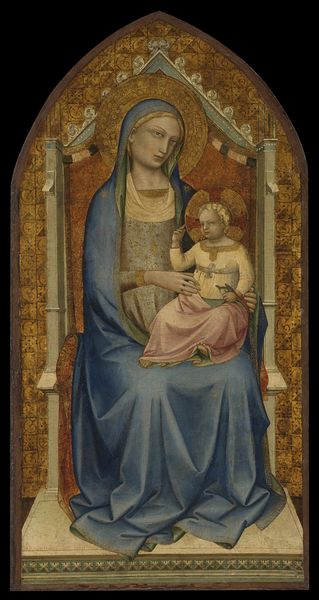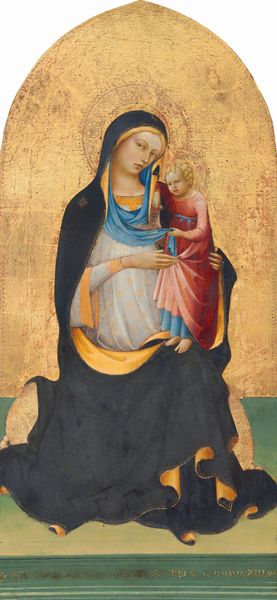![Madonna and Child Enthroned with Twelve Angels, and with the Blessing Christ [middle panel] by Agnolo Gaddi](/_next/image?url=https%3A%2F%2Fd2w8kbdekdi1gv.cloudfront.net%2FeyJidWNrZXQiOiAiYXJ0ZXJhLWltYWdlcy1idWNrZXQiLCAia2V5IjogImFydHdvcmtzLzc2ZTgxNThmLTgzOTctNDc4OC1iMDcwLTQzNzY2ZDJiZjYyMS83NmU4MTU4Zi04Mzk3LTQ3ODgtYjA3MC00Mzc2NmQyYmY2MjFfZnVsbC5qcGciLCAiZWRpdHMiOiB7InJlc2l6ZSI6IHsid2lkdGgiOiAxOTIwLCAiaGVpZ2h0IjogMTkyMCwgImZpdCI6ICJpbnNpZGUifX19&w=3840&q=75)
Madonna and Child Enthroned with Twelve Angels, and with the Blessing Christ [middle panel] before 1387
0:00
0:00
tempera, painting
#
portrait
#
medieval
#
allegory
#
tempera
#
painting
#
figuration
#
oil painting
#
history-painting
#
italian-renaissance
Dimensions: overall: 204 × 80 cm (80 5/16 × 31 1/2 in.)
Copyright: National Gallery of Art: CC0 1.0
Editor: This artwork projects an immediate sense of ethereal calm. The blues and golds work wonderfully together, giving a celestial feeling to the entire scene. Curator: Indeed. Here we have "Madonna and Child Enthroned with Twelve Angels, and with the Blessing Christ," the middle panel of a triptych by Agnolo Gaddi, painted before 1387 using tempera on panel. The piece emphasizes a strong vertical orientation. Editor: I'm fascinated by the repetitive, almost manufactured quality of the angels' faces. It speaks volumes about workshop practices. Were many hands involved in creating such works? The scale of production must have influenced the final artifact significantly. Curator: That’s a very insightful observation. The angels flanking the Madonna operate more as visual elements, stylized supports to elevate the central figures, rather than distinct personalities. Look closely at how Gaddi uses line and symmetry to reinforce this hierarchy. The triangular structure, crowned by the blessing Christ, creates a rigorous geometric framework. Editor: And consider the intensive labor! Preparing the panel, grinding pigments, applying the gold leaf, then painting in tempera—each step demanded specialized skill. This wasn’t simply about artistic genius; it was about a collective mastery of materials and techniques. Curator: Precisely! The material choices themselves carry significance. The gold background symbolizes divine light and illuminates the entire composition with its reflective properties, adding to the flattening of space we see here. Editor: The raw materials likely came from diverse sources, passing through numerous hands. The lapis lazuli for that striking blue in Mary's cloak—its extraction, trade, and arrival in Gaddi's workshop constitute a hidden history. Curator: I agree, the material’s journey enriches our understanding. But return your gaze to the figures, and let's also appreciate the intricate interplay between line and color. Notice how Gaddi delineates form through carefully placed contours and the symbolic deployment of color. The azure blue, for example, evokes Mary’s divine role, contrasting the fleshy tones to emphasize her detachment from mortality. Editor: Thinking about the tangible effort poured into it helps me connect with this image on a deeper level. To ponder those actions… Curator: For me, dwelling on the structure and how this form generates content allows me to move past iconography and enter the artist’s universe.
Comments
No comments
Be the first to comment and join the conversation on the ultimate creative platform.
